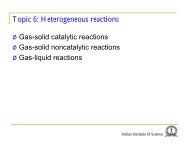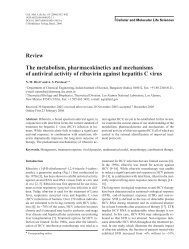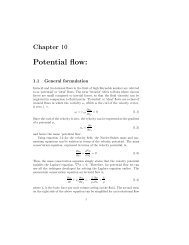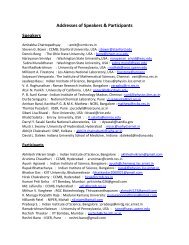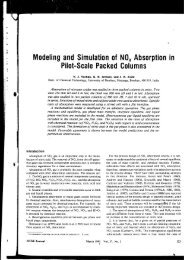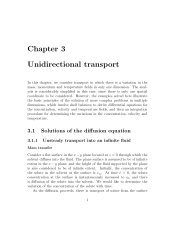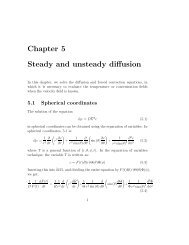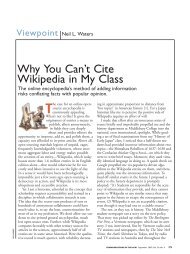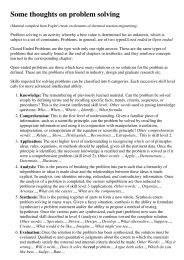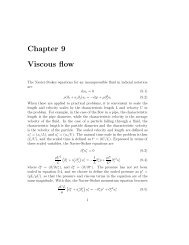Chapter 11 Boundary layer theory
Chapter 11 Boundary layer theory
Chapter 11 Boundary layer theory
Create successful ePaper yourself
Turn your PDF publications into a flip-book with our unique Google optimized e-Paper software.
From equation <strong>11</strong>.20, the pressure is only a function from the leading edge<br />
of the plate x, and not a function of the cross-stream distance y. Therefore,<br />
the pressure at a displacement x from the leading edge is independent of the<br />
normal distance from the plate y. However, in the limit y → ∞, we know<br />
that the free stream velocity U ∞ is a constant, and the pressure is a constant<br />
independent of x. This implies that the pressure is also independent of x as<br />
well, and the term (∂p/∂x) in equation <strong>11</strong>.19 is equal to zero. With this,<br />
equation <strong>11</strong>.19 simplifies to,<br />
(<br />
)<br />
∂u x<br />
ρ u x<br />
∂x + u ∂u x<br />
y = µ ∂2 u x<br />
(<strong>11</strong>.21)<br />
∂y ∂y 2<br />
This has to be solved, together with the mass conservation condition equation<br />
<strong>11</strong>.9, to obtain the velocity profile.<br />
We look for a similarity solution for the above equation, under the assumption<br />
that the stream function at a location (x, y) depends only on the<br />
distance x from the leading edge of the plate and the cross-stream distance<br />
y, and not on the total length of the plate. The justification for that momentum<br />
is being convected downstream by the flow, and so conditions at<br />
a trailing edge of the plate at x = L should not affect the velocity profile<br />
upstream of this location. While scaling the spatial coordinates and velocities<br />
in equations <strong>11</strong>.12, <strong>11</strong>.15 and <strong>11</strong>.18, we had used the dimensionless y<br />
coordinate<br />
y ∗ =<br />
y<br />
Re −1/2 L =<br />
5<br />
y<br />
(νL/U ∞ ) 1/2 (<strong>11</strong>.22)<br />
Since we have made the assumption that the only length scale in the problem<br />
is the distance from the leading edge x, it is appropriate to define the<br />
similarity varible using x instead of L in equation <strong>11</strong>.22,<br />
η =<br />
y<br />
(νx/U ∞ ) 1/2 (<strong>11</strong>.23)<br />
This scaling implies that the thickness of the boundary <strong>layer</strong> at a distance x<br />
from the upstream edge of the plate is proportional to (νx/U ∞ ) = xRe −1/2<br />
x ,<br />
where Re x = (U ∞ x/ν) is the Reynolds number on the distance from the<br />
upstream edge. It is appropriate to scale the velocity in the x direction<br />
by the free stream velocity U ∞ , while the scaling for the velocity in the y<br />
direction is obtained by replacing L by x in equation <strong>11</strong>.12,<br />
u ∗ x = u x<br />
U ∞<br />
(<strong>11</strong>.24)



